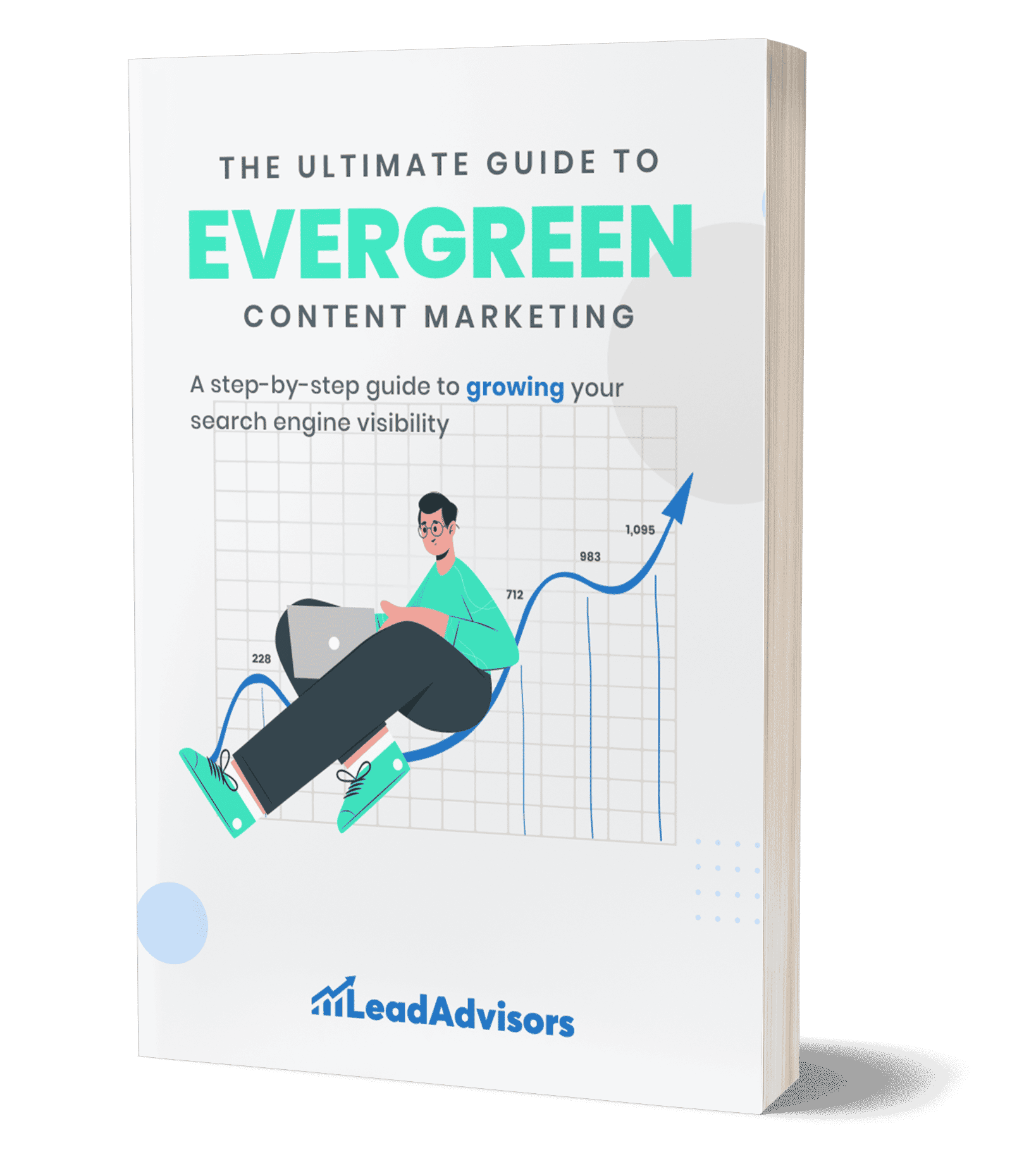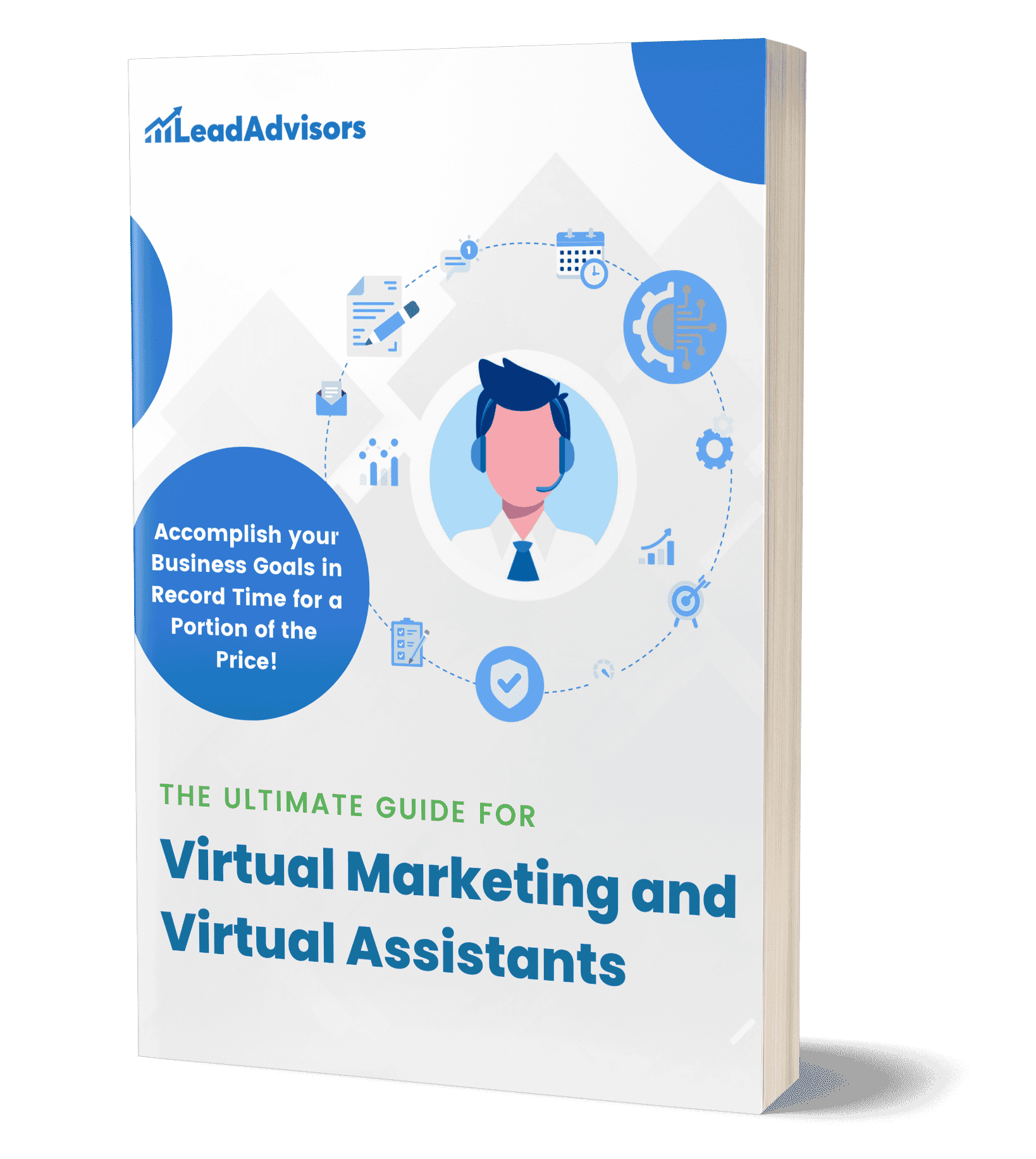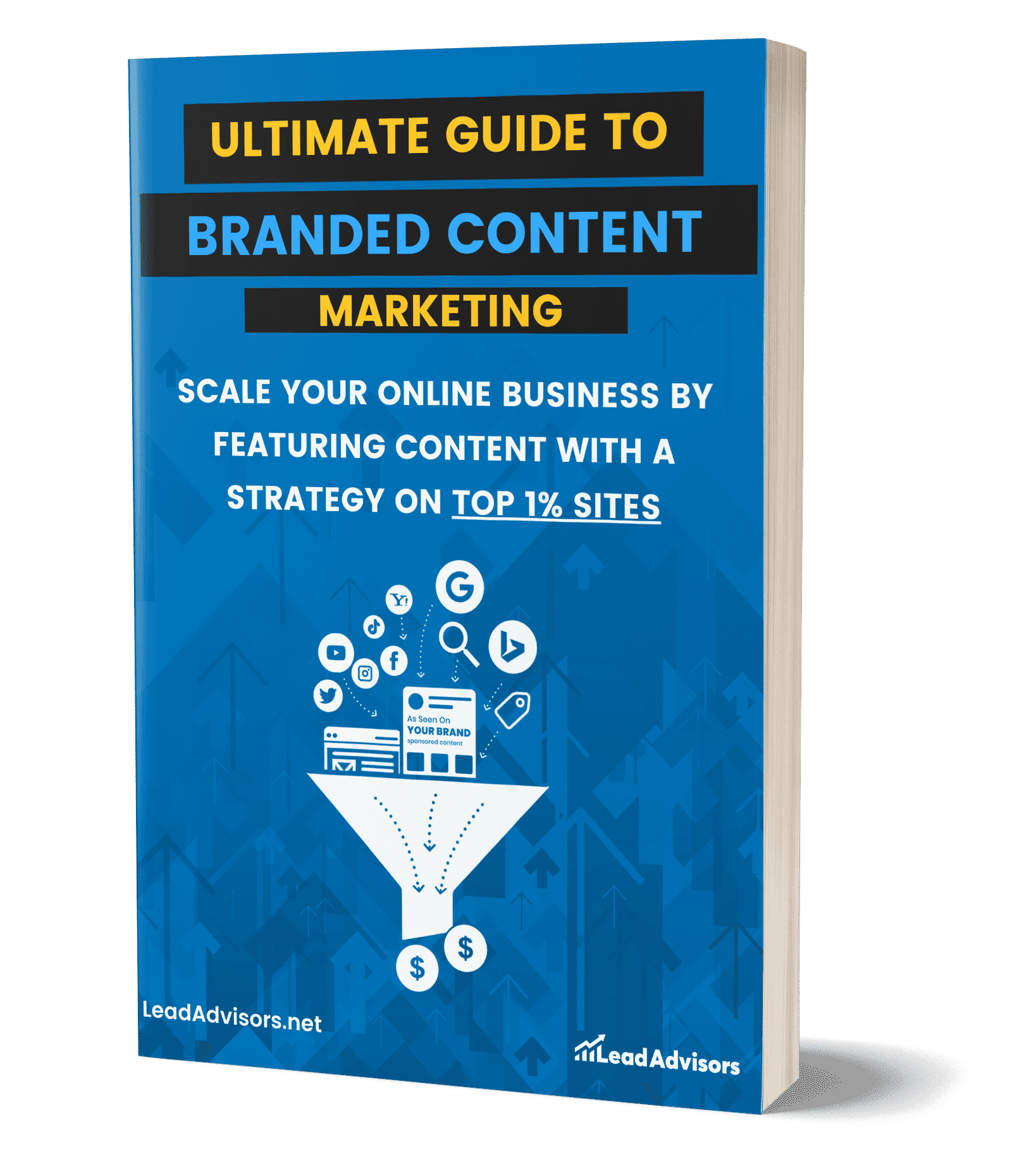Getting media coverage isn’t just a fancy PR buzzword—it’s one of the most powerful tools to build credibility, raise brand awareness, and position yourself as a thought leader. It’s how people outside your inner circle discover who you are and what you stand for. And no, you don’t need to be a celebrity or a Fortune 500 brand to get noticed.
The truth is, news coverage comes in many forms: a journalist writing about your latest project, a feature in your local newspapers, a guest spot on a podcast, local TV stations, or even a brief mention on a morning show. Whether it’s earned media (organic and based on story value), paid placements (sponsored content), or a mix of both, the key is knowing how to present your story in a way that gets attention—and keeps it.
In this blog, I’ll show you how to obtain media coverage and how to make the most of it once it lands.
What Is Media Coverage (And Where Do Editorial Reviews Fit)?
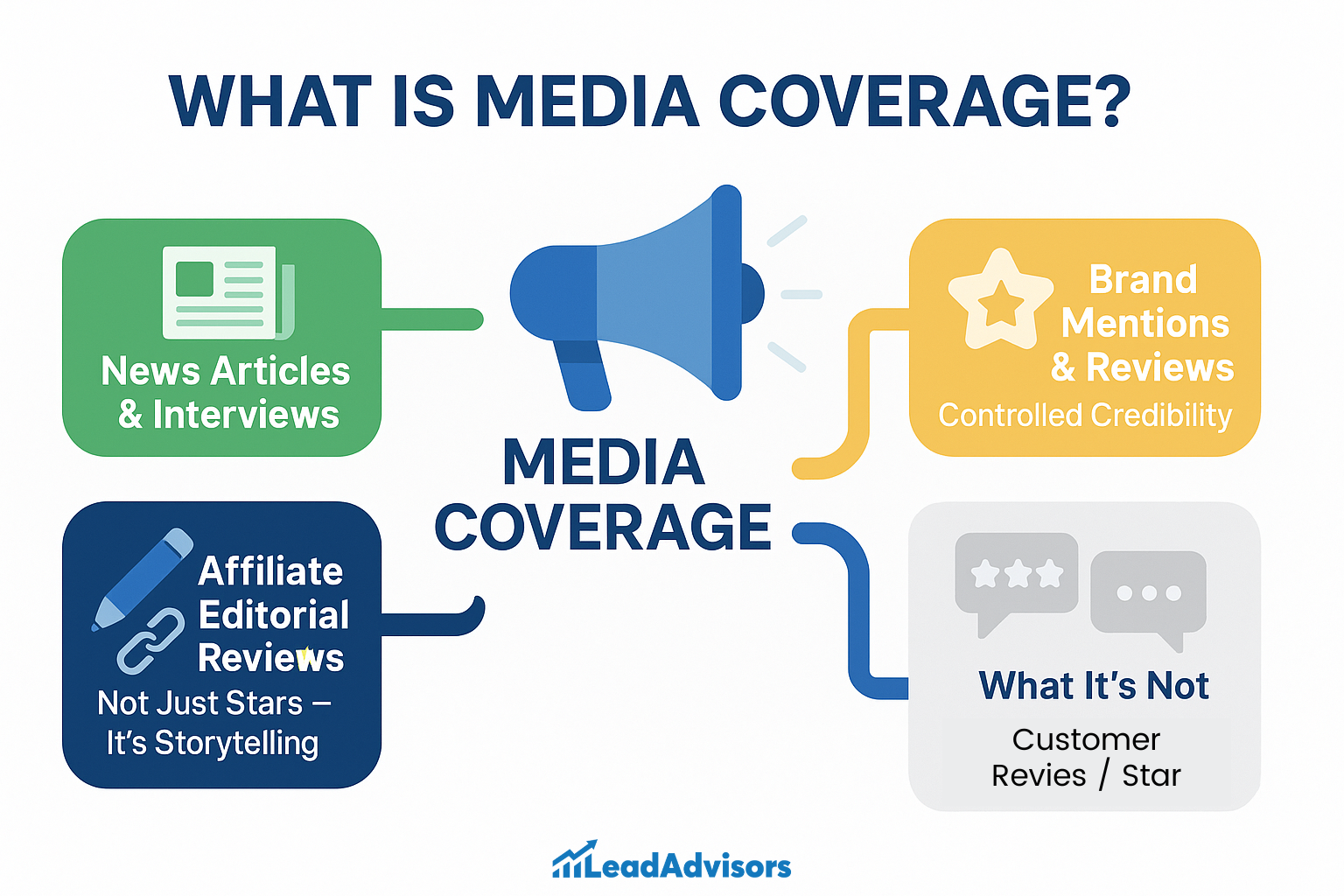
Media coverage isn’t just about landing a headline in The New York Times, though that’s always a great goal. It comes in many forms, each with its own value. News coverage can include articles, interviews, expert quotes, or features where your name or brand gets mentioned.
Editorial reviews and brand mentions—like being featured in a “Top 10” list or a product roundup—offer credibility without sounding too promotional. These types of reviews help build trust and authority.
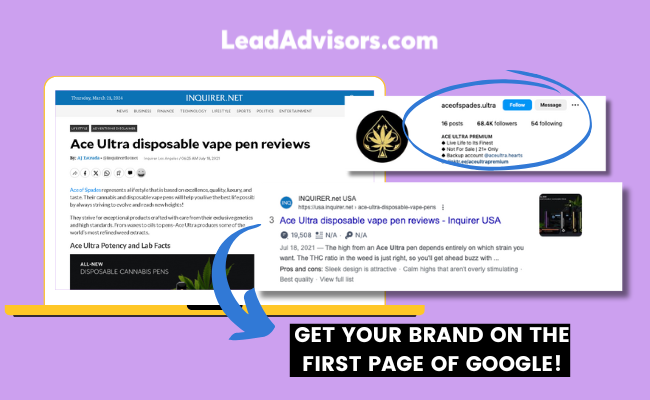
Now let’s talk affiliate editorial reviews. They combine the trust factor of earned media with some brand input, like images or key messages you provide. They often include an affiliate link, meaning if someone clicks and buys, the publisher earns a commission.
Just to clarify: customer reviews on platforms like Yelp or Google are useful for social proof, but they typically don’t have the same reach or storytelling strength as editorial coverage from established media outlets like TV and radio stations.
The key takeaway? Media coverage comes in different formats. Understanding how editorial and affiliate editorial reviews fit into your strategy helps you focus on the types of news coverage that truly amplify your brand.
Why Media Coverage Matters More Than Ever
At LeadAdvisors, we know media coverage does more than just make you look good—it drives real results.
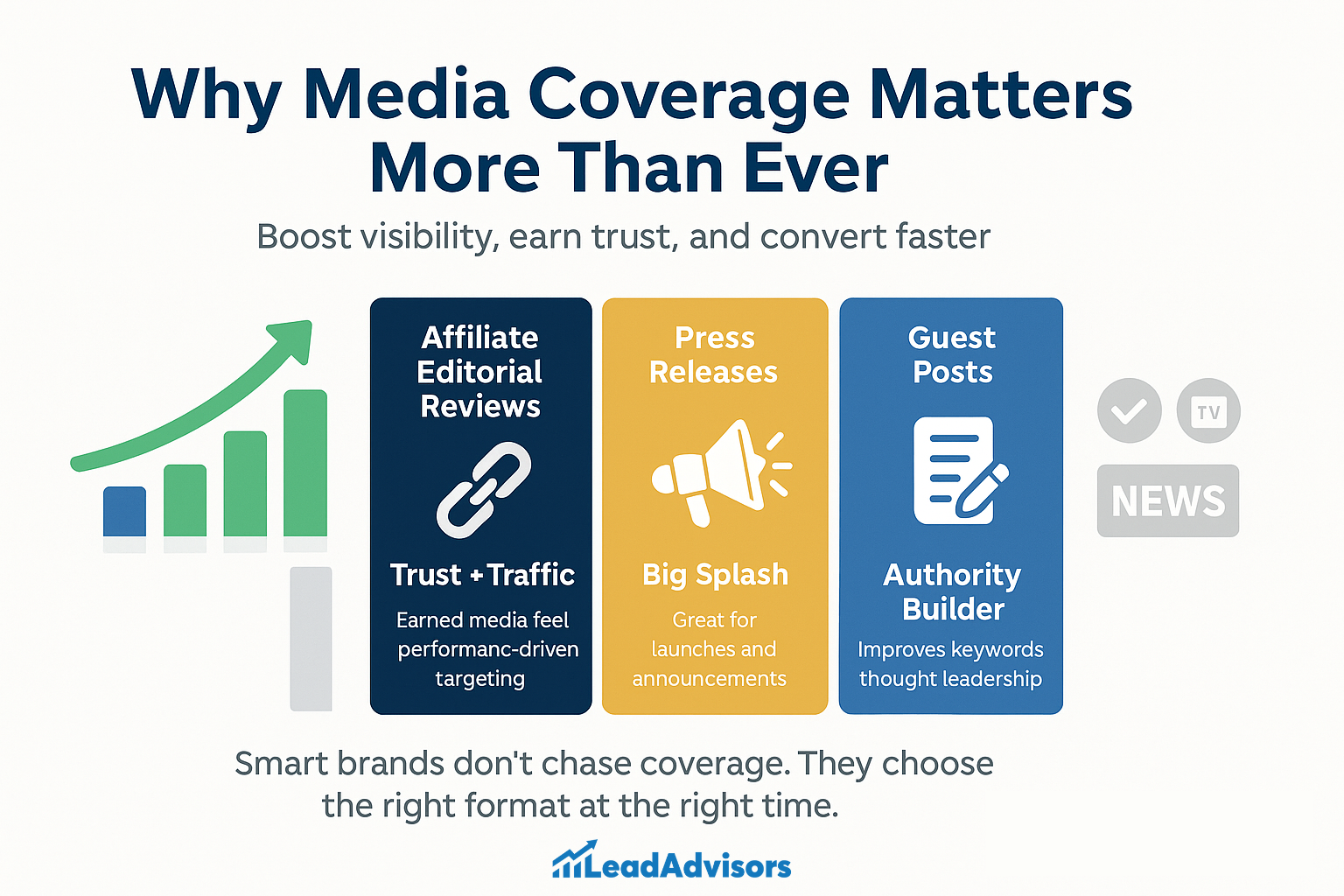
When your brand is featured in the right places, it boosts your visibility, builds credibility, and earns trust with the people who matter most—your target audience. And let’s not forget the technical bonus: it helps your SEO game through high-authority backlinks that improve your rankings and help you convert faster.
Here’s how different formats stack up (and yes, we’ve tested them all):
Affiliate editorial reviews (our specialty)
These combine the trust factor of earned media with the precision of performance-driven targeting. Translation? They’re excellent for both traffic and sales.
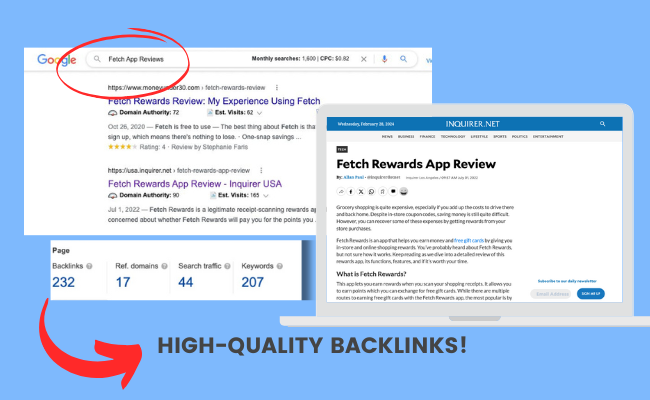
Press releases
Perfect for timely announcements—whether it’s a product launch, event, or company milestone. Think of them as your instant credibility boost. Big splash, fast.
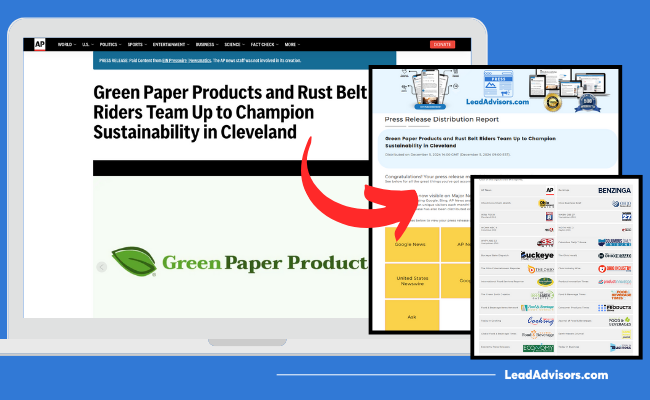
Guest posts
Ideal for building long-term authority. They help improve your keyword presence over time while positioning you as a go-to voice in your space.
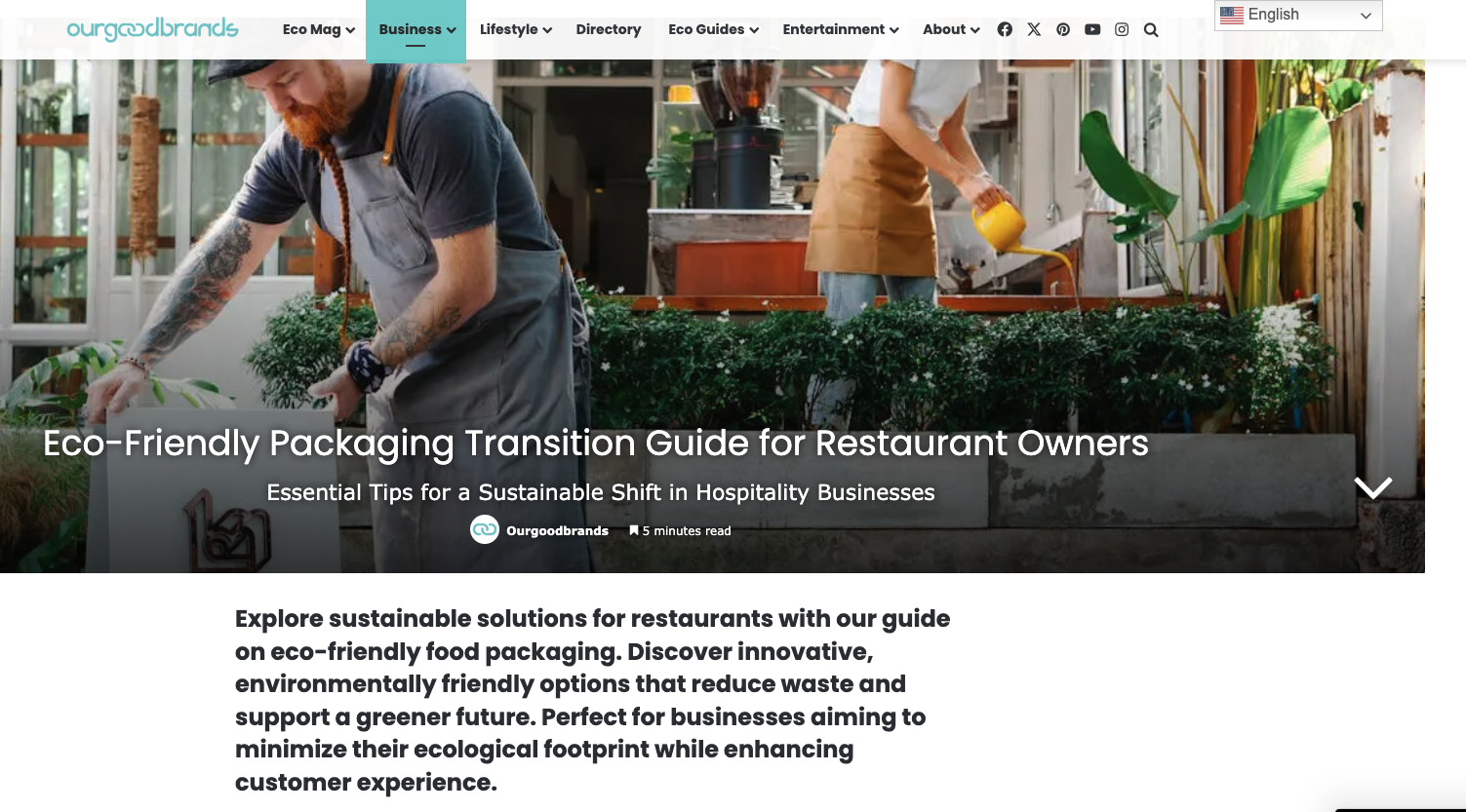
Smart brands securing media coverage for the sake of it. They use the right type at the right time—and that’s where we come in. Whether you’re gunning for exposure, leads, or a trust boost, choosing the right media strategy is everything.
How to Get Media Coverage
So, how do you actually get media coverage without paying for it? It all starts with being genuinely interesting and knowing how to share your story in a way that a journalist (or an editor!) would care about. Organic media coverage isn’t about luck—it’s about clarity, connection, and strategy.
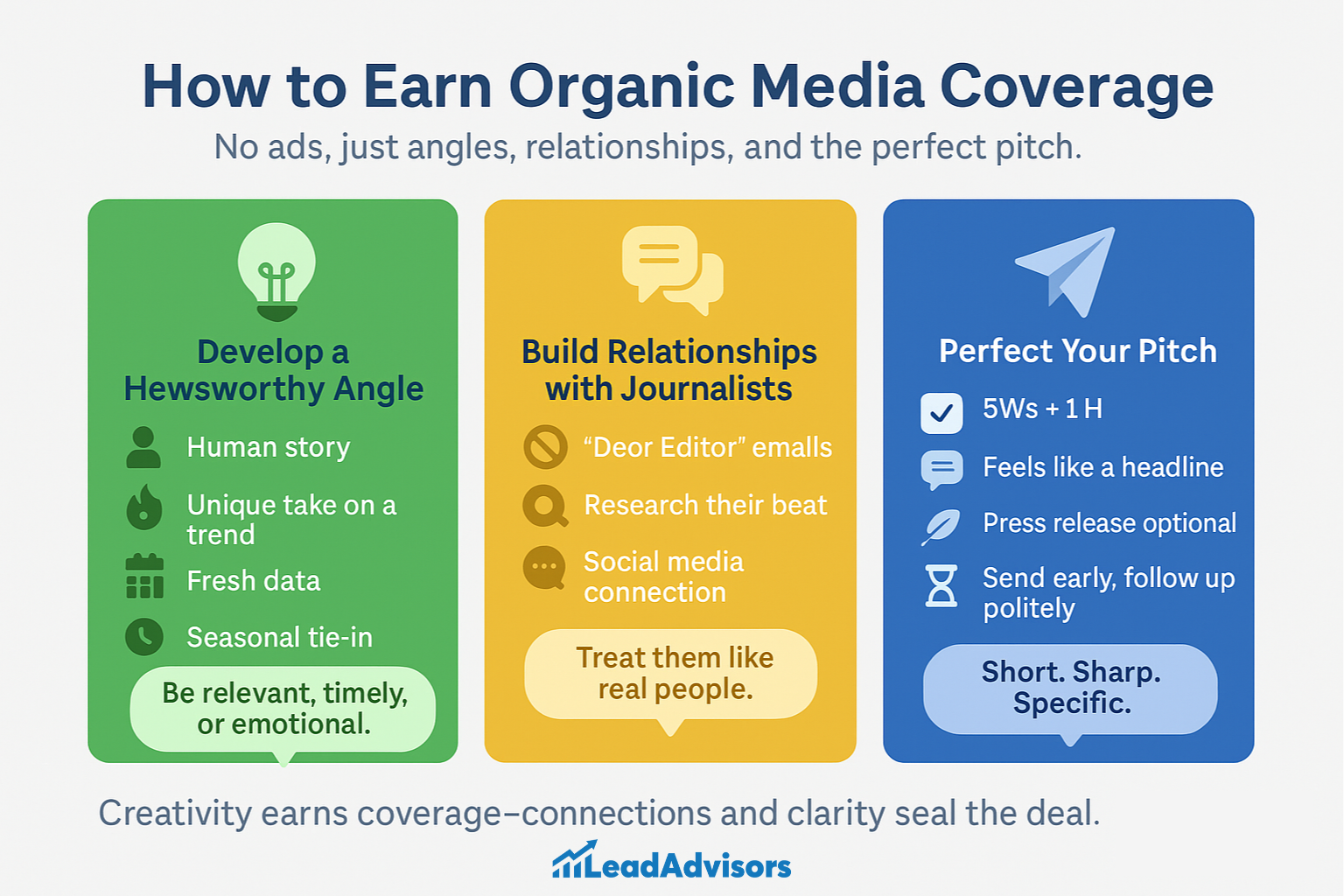
A. Develop a Newsworthy Angle
You can’t just say, “Hey, cover me!” and hope for the best. Print reporters are always hunting for compelling stories that are relevant, timely, or emotionally compelling. If you want your email to stand out in their crowded inboxes, your pitching strategy needs to offer real value.
Here’s what helps:
- A human-centered story that makes people feel something
- A fresh, bold take on a trending news topic
- Original data or provide valuable insights they haven’t seen before
- A seasonal tie-in like “Back-to-School,” “Holiday Shopping,” or “New Year, New Finances”
If a local media outlet like Wake Tech or a government organization like the DOT can find angles that earn media coverage, trust me—you can, too. It just takes a little creativity and a lot of relevance.
B. Build Relationships with Journalists and Media Professionals
This part’s gold. Journalists and notable bloggers are more likely to cover people they know, trust, or have had meaningful interactions with. They’re not just looking for pitches—they’re looking for people who make their job easier.
Here’s how to start:
- Ditch the “Dear Editor” emails (they know it’s lazy—and it feels cold)
- Research what each journalist actually covers before reaching out.
- Engage on social media platforms—comment on their stories, reply thoughtfully, and be present.
- Schedule casual Zoom intros or desk-side briefings to offer story ideas and say hey.
Treat them like humans, not just megaphones for your next press release.
C. Perfect Your Pitch
Now that you’ve got your angle and your media contacts, it’s time to write your pitch—and make it stick.
Ask yourself:
- Have I clearly answered the who, what, when, where, why, and how?
- Does my subject line read like a headline? Make it short, sharp, and scroll-stopping.
- Should I include a mini press release, or is a quick summary more effective for this one?
- Am I getting this out before the trend peaks, or after the news cycle has passed?
And don’t hit send and disappear. A friendly, respectful follow-up (once or twice) can go a long way. Timing is everything, but consistency and courtesy? That’s how you stay on their radar.
Editorial Reviews and Sponsored Content: A Strategic Shortcut
Sometimes, waiting for organic media coverage just doesn’t cut it. That’s where sponsored content and editorial reviews step in as the smart shortcut—and at LeadAdvisors, we’ve seen them work wonders when used with intention and strategy.

A. Types of Sponsored Content (LeadAdvisors)
There are a few clever ways to get your brand in front of the right audience fast. From sponsored articles and branded posts on social media to native ads and influencer video collaborations, each format has its unique role in the funnel.
But one format continues to crush it: affiliate editorial reviews.
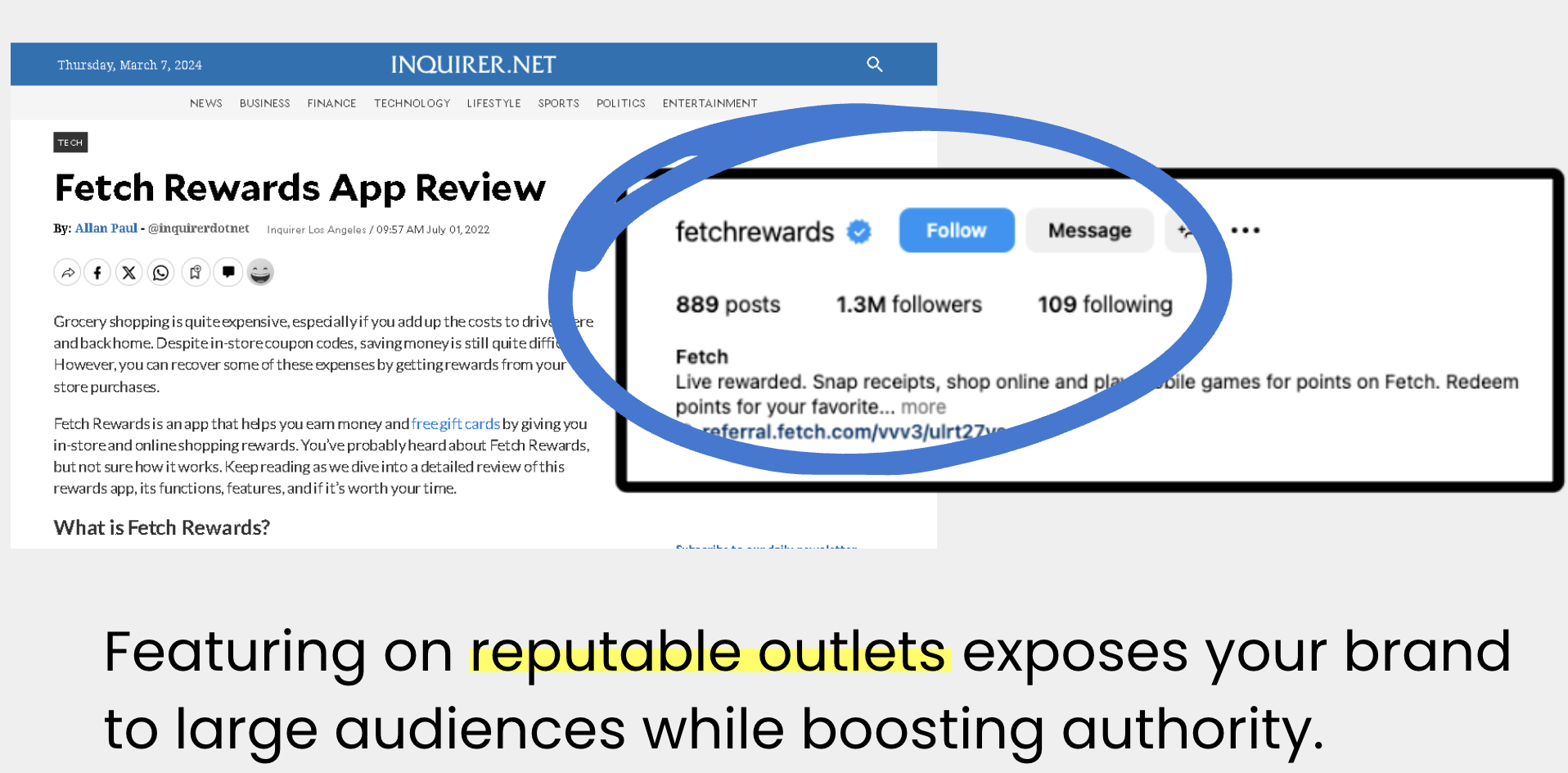
They’re powerful because they feel like earned media, but still give you enough control to nail your key messages. Add in built-in credibility, SEO perks, and the trust that comes with being featured by respected media outlets, and it’s no surprise these reviews generate some of the highest ROI.
B. When to Use Editorial Reviews
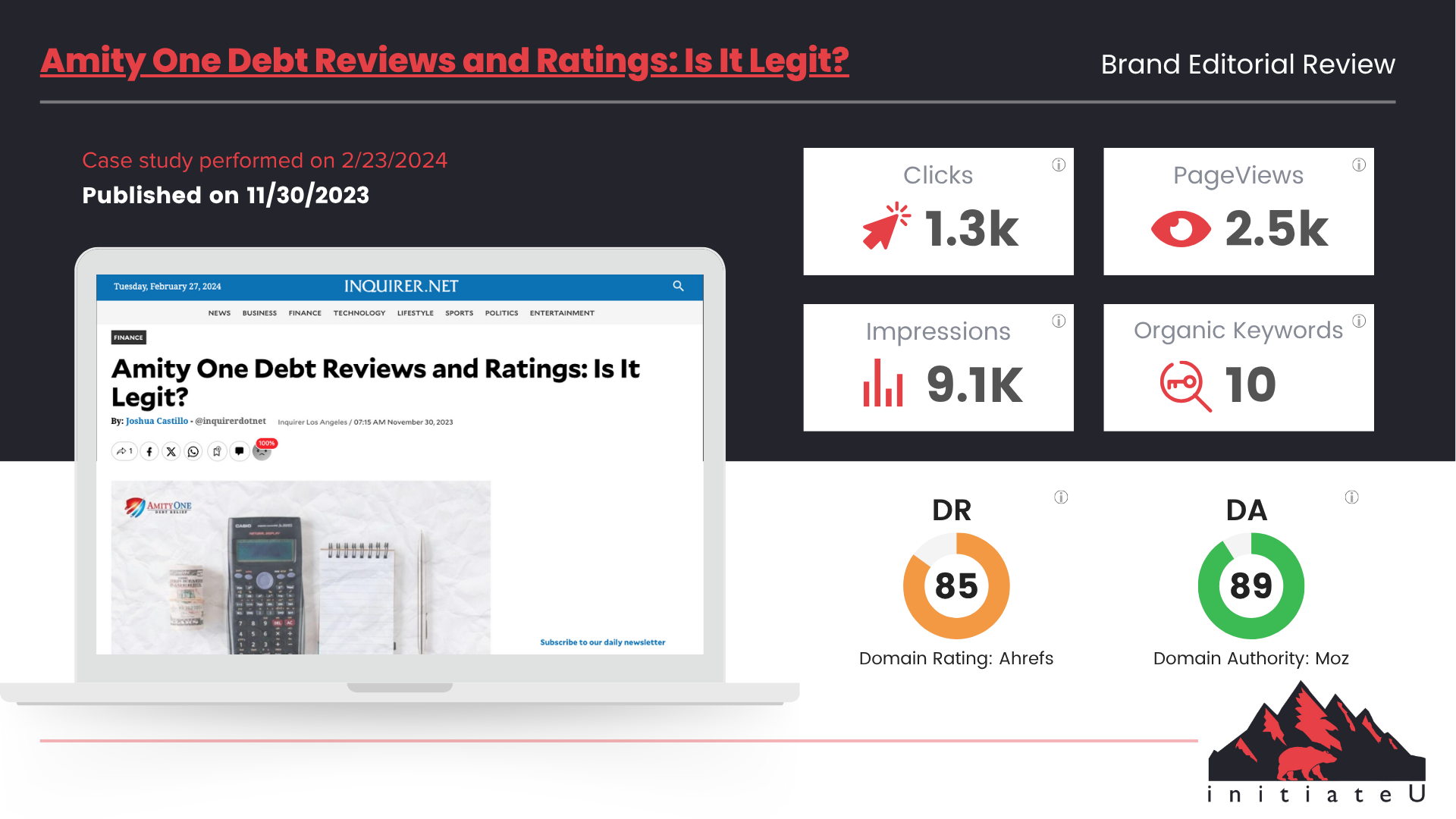
Editorial reviews are more than just a visibility play—they’re a strategic move. They work best when you want to:
- Bounce back after a wave of negative reviews
- Launch something new and make an unforgettable first impression.
- Dominate high-intent keywords that your target audience is already searching.
- Position your brand (or leadership team) as trusted experts in your niche
They’re sticky, rank, and convert—without coming off like a sales pitch.
C. Real-World Examples (LeadAdvisors Case Studies)

We’ve seen this strategy deliver in real time. One of our clients, WTSO, used editorial reviews to clean up its online rep and saw a 25% lift in conversions. A camera flash brand landed 37,000 visits and five juicy backlinks from a single feature. And a fashion retailer? They increased their domain authority by three points and watched their organic traffic grow 10x.
So yeah—these aren’t fluff metrics. They’re proof that, when you’re ready to move with intention, editorial reviews can bring in the kind of media coverage that delivers real, lasting results.
Amplify Your Media Coverage
Landing a feature is great, but expanding on it? That is where the money is made. Media coverage is the spark, if you will. These next steps? They’re how you can make that spark into a full-on fire.
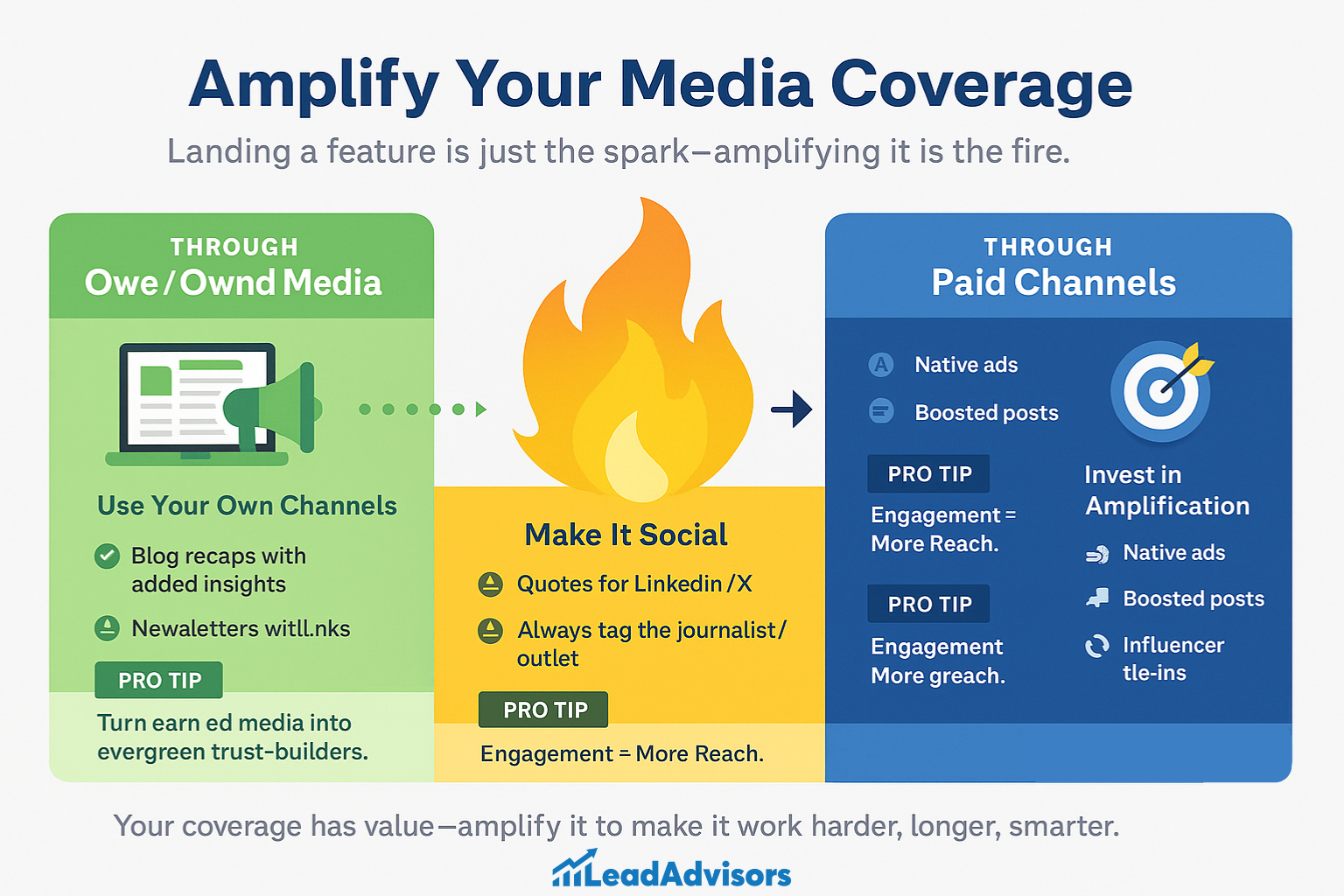
A. Through Owned Media
Let’s begin with what you have ownership over — your owned media. This is the simplest, most underrated method of getting a better deal on your coverage.
Here’s how to do it:
- Blog posts – Summarize the feature and add your takeaways or valuable insights.
- Newsletters—In your next email blast, include a short blurb and a link. It’s easy, effective, and keeps your audience in the know.
- Landing pages – Include trust-enhancers like logos, press mentions, or pull quotes to boost conversions.
B. Through Shared Media
Don’t let that media shout-out fade to silence — share it where your target audience already is, scrolling. Spin it into social media gold.
Here’s how to break it down:
- Make sharp quotes or facts mini-posts for LinkedIn or X (Twitter)
- Post behind-the-scenes or reaction videos through Instagram Stories or Reels.
- Tag the journalist or media outlets—they just might re-post it, amplifying your reach.
It’s not even a matter of reposting. It’s a time to celebrate the ongoing coverage and interact with the people who made it possible.
C. Through Paid Channels
Now, let’s turn to how you might be able to turn media coverage stories about you into gasoline for paid campaigns.
Paid strategies that are smart include:
- Native ads that appear in high-traffic content feeds promoting your editorial review
- Targeted boosted posts across social media platforms that can be honed in on your exact target audience
- Influencer collabs for the human voice and social proof
- Retargeting campaigns to catch those warm leads who just need another nudge
Here at LeadAdvisors, we’ve consistently witnessed native ads plus solid editorial reviews outshine traditional display ads — especially when a killer retargeting operation is added to the mix.
Press Releases vs. Sponsored Content vs. Guest Posts (LeadAdvisors Deep Dive)
There’s no one magic bullet media strategy, but if you understand when to opt for a press release over sponsored content or guest posts, you can save yourself time, stress, and budget.
Let’s deconstruct with a quick cheat sheet here:
| Strategy | Best For | Challenges |
| Sponsored Content | Engagement, trust, and visibility | FTC compliance, higher cost |
| Press Releases | News announcements, building credibility | Short shelf life, often overlooked |
| Guest Posts | SEO growth, industry thought leadership | Time-intensive, limited brand control |
Each format has a job to do.
- Put out a press release when you’ve got something newsworthy — a new product launch, partnership, or company milestone that is worth announcing. It’s quality for quick credibility, but remember that the buzz usually dissolves fast.
- Sponsored content is where you will head for fast visibility, firmer control over messages, and audience outreach. When executed correctly, it works, but you need to be careful to follow FTC guidelines and consider the cost.
- Guest posts are EPs. They contribute to building authority, increasing keyword presence, and achieving consistent results over time. Just be prepared to put in the work — they’re a longer haul to produce, pitch, and place.
All right, before we proceed, let’s discuss the proven format used by the LeadAdvisors: the affiliate editorial review.
They combine the best of all three—trust-building media coverage, control over sponsored content, and the lasting SEO value of a guest post—into a concentrated power player. We’ve said it before, and we’ll say it again—as far as formats go, not a single thing provides the long-term value of affiliate editorial reviews.
So, you think strategy? Think smart. Think hybrid. Think results.
How to Measure and Analyze Your Coverage
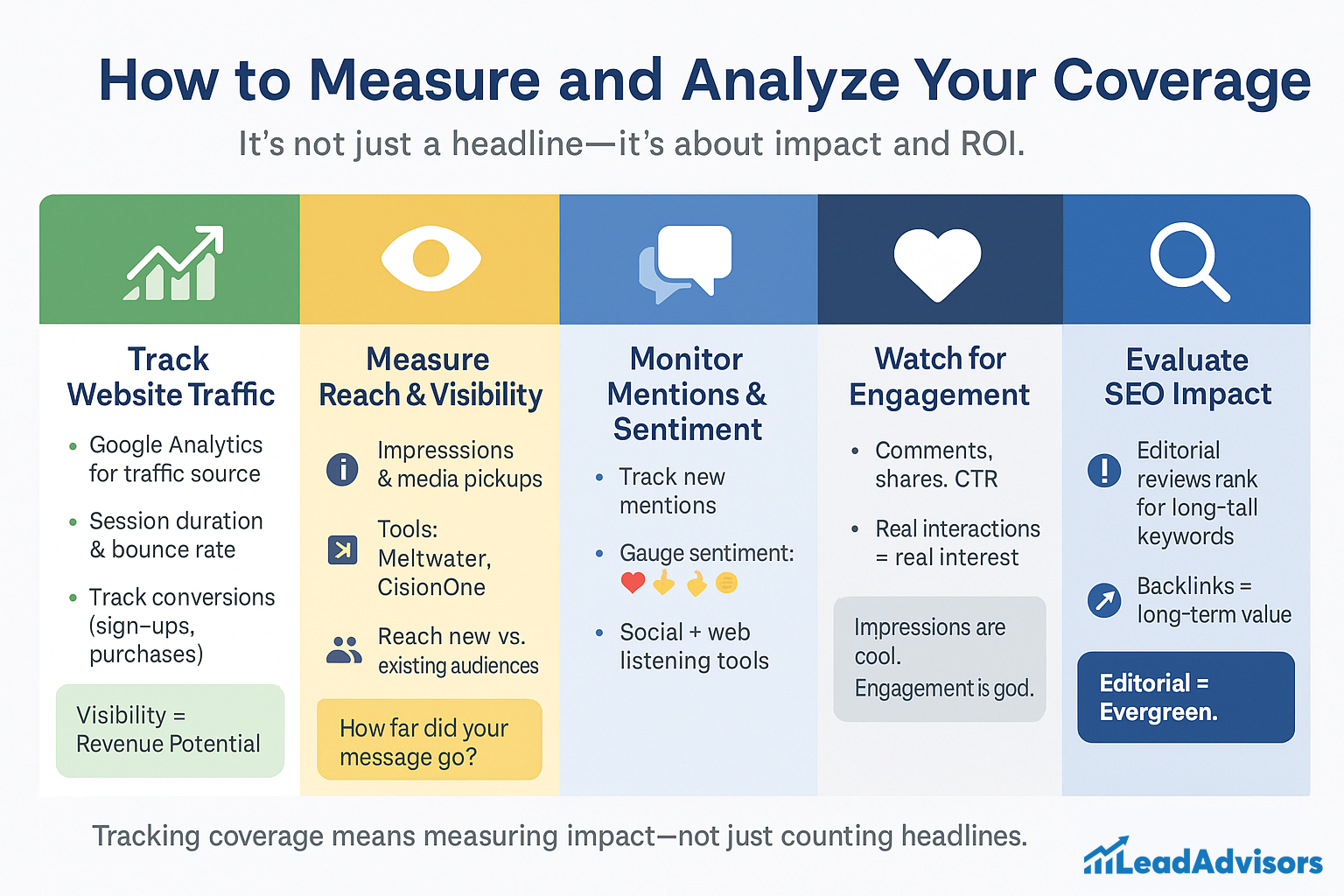
A positive media coverage is thrilling (cue the happy dance), but it shouldn’t end at a headline and a high-five. If you want your work to have a real impact, you must work with the data. “By measuring something, you can better understand its impact on your brand in the wild, not simply in terms of clicks, but in terms of trust, visibility, and real results.
Here’s how to track your wins the smart way:
Step 1: Track Website Traffic
The first place you want to go is your website. Once your media coverage has gone live, there’s another piece: analyzing it. Did you have a bump in visitors? Are they chilling or bouncing?
Use Google Analytics to:
- Drill down on traffic sources. Was it from the article, a social media post, or the subject line of a newsletter?
- Examine session durations and bounce rates -Are you drawing the attention of inquisitive clickers or seriously engaged visitors?
- Monitor conversions—Were those visits converted into purchases, sign-ups, or other goals?
When traffic scales, when leads convert, that’s not just media coverage, that’s revenue-driving reach.”
Step 2: Measure Reach and Visibility
Next up, how far did your message actually travel? Tools like Meltwater or CisionOne help you track:
- Total impressions—how many people might have seen your story
- Which media advisory and journalists reported it, or shared it on media outlets
This provides a much clearer picture of reach—are you reaching new audiences or simply doubling down on your base?
Step 3: Monitor Brand Mentions and Sentiment
The reporters ignite most of my conversations from the start. What people really want to know, though, is what people say.
Track:
- New brand mentions across the web and social media platforms.
- Tone and sentiment — Are reactions glowing, meh, or furrowed eyebrows?
You learn about sentiment to see if your key points landed or need a tweak.
Step 4: Watch for Engagement
Impressions are cool. But engagement? That’s where the magic is.
Look for:
- Comments and conversations around your media feature
- Social shares and reposts
- Click-through rates on links in or linking to your coverage
More engagement = more interest = more opportunities to be in touch with your audience.
Step 5: Evaluate Long-Term SEO Impact
Editorial reviews are really coming into their own here. A press release may be a quick hit, but a well-placed editorial review can deliver for months or years.
Here’s why:
- They’re high-intent keywords or phrases that are likely to drive organic traffic.
- They acquire backlinks from trustworthy websites.
- They improve the credibility of your brand and convert in a while
At LeadAdvisors, we treat editorial reviews as evergreen content — smart investments that become more valuable and deliver ongoing search engine optimization results.
The bottom line? This isn’t about chasing vanity metrics when you measure your media coverage. It makes your stories flow into the brand growth, awareness , and sustainable impact.
Take Control of Your Brand Narrative
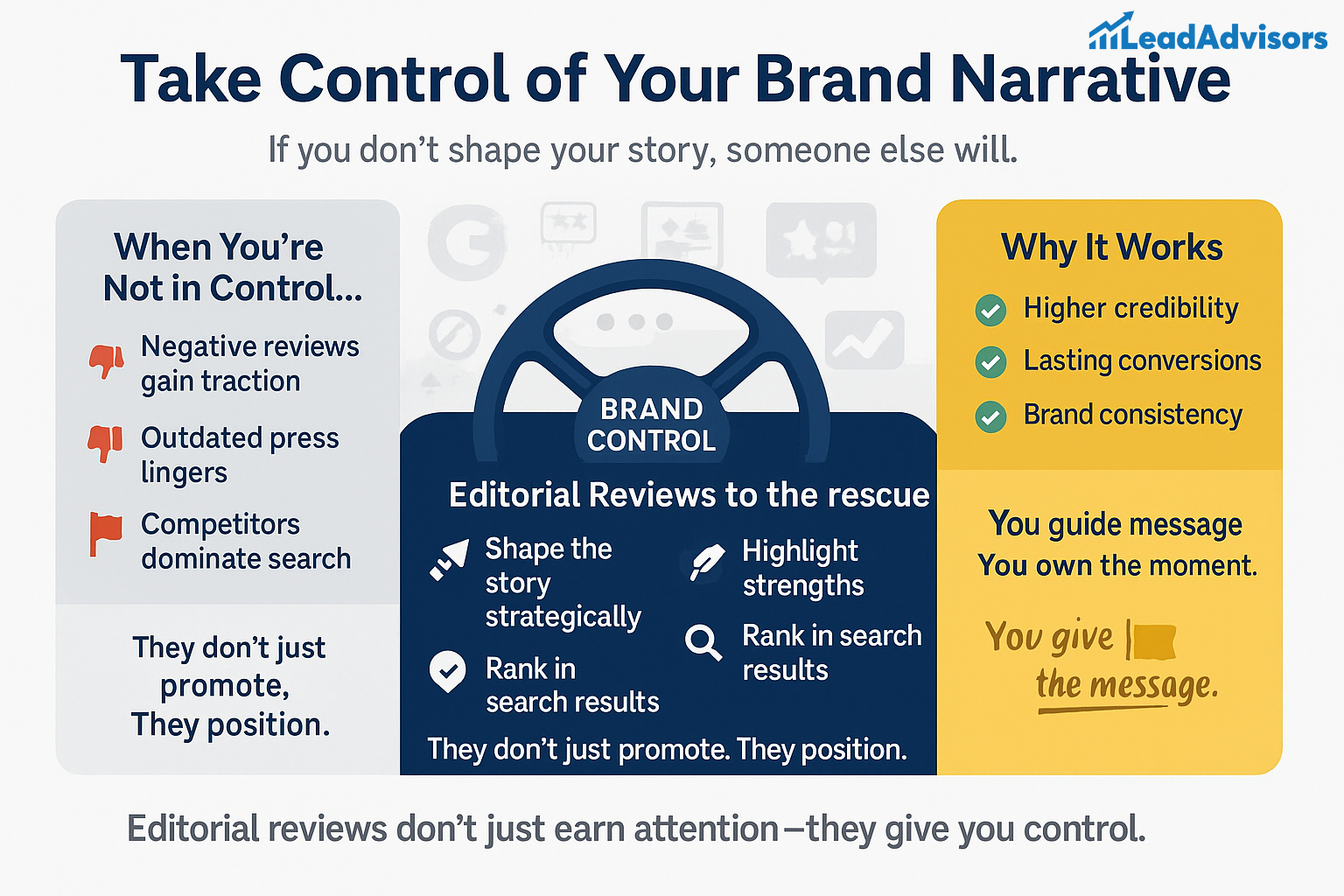
Here’s the truth: if you don’t shape your brand story, someone else will.
A string of poor reviews, dusty articles floating out there or competitors hogging the top of search results, and you can quickly lose control of the narrative that others see online. But the good news? You needn’t cross your fingers and subsidize.
This is precisely where editorial reviews have become a game-changer. They aren’t just for promotion—they’re about proactive storytelling and smart media strategy.
Well, with editorial content, you can:
- Guide your narrative
- Focus on your brand’s unique aspects.
- Be there when it matters most in search results.
- Establish trust without being advertising-y.
That’s because they’re written in the style of actual local media coverage that you naturally trust, and they achieve long-term conversions.
Editorial reviews rank, convert, and continue to work for you long after you’ve published them.
So instead of allowing Google — or, even worse, your competitors — to tell your story, take the wheel. With a thoughtful strategy, media attention transforms from a visibility play into something more. It is a brand-building machine you really control.
Conclusion: Blend Strategy with Storytelling
If there’s one thing I want to leave you with, it’s this: good media coverage is not a coincidence. It is about having a smart, adaptable plan — and knowing how to tell your story in a way that makes it stand out.
The best brands out there aren’t playing with earned media or sponsored content or editorial reviews. They’re mixing all three—strategically—to keep from disappearing, to gain credibility, and to be remembered in a way that advances brands as authentically chiming in on a cultural moment.
Whether you’re tweaking your pitch, amplifying your most recent series of ongoing news coverage, or leveraging editorial content for long-term SEO, there is a media mix that works with your goals and budget.
And here’s the good news: You don’t have to solve it alone.
Partner with LeadAdvisors to build an editorial content strategy that ranks, converts, and gets you the visibility you deserve.
We are experts at helping brands like yours build performance-driven media strategies where story and result are organized. Ready to take control of your brand narrative and get the media coverage that really counts?
👉 Schedule your free strategy call today.
Let’s make your story the one everyone’s talking about.





